"To me it made no sense to pull one of even a few objects out of the swarm and call them something other than part of the swarm." -Mike Brown, A.K.A. PlutoKiller
In our Solar System, the four rocky planets dominate the inner portion, while the four gas giants dominate the outer Solar System. But out beyond Neptune, thousands of icy, rocky worlds -- including Pluto, the former ninth planet -- make up a vast, wide ring known as the Kuiper Belt.
What began as a curious collection of a few icy worlds has since revealed itself to us as an incredibly busy place, where -- since 1992 -- literally hundreds of worlds have been discovered.
And while some of these objects (like Pluto) are big, round spheres, most of these objects don't quite have enough gravity to pull themselves into a spherical shape.
As always, of course, there are some oddballs. Take a look at Haumea, which does have enough gravity to pull itself into a sphere, but is rotating so quickly that its shape has become distorted into an ellipsoid!
One of the ways we can learn a whole lot about a foreign world, even if it only takes up one pixel on a camera, is to watch how its light-curve changes over time.
Think about it in terms of our Moon.
No matter how far away you were from the Moon, so long as you could see it at all, you'd be able to measure a certain amount of light coming from it. And if the Moon rotated so that you could see different amounts of the near-and-far-sides over time, you would find that the amount of light you observed changed over time, in a periodic way, depending on which face you were looking at.
Well, what about Haumea, the irregular ellipsoid I showed you above? Let's take a look at her light-curve and see what it looks like.
The curve shows us that not only is one side brighter than the other (why the left side is brighter than the right), but we can also see different amounts of the planet over time (why there are the big bright peaks and deep valleys)!
Moreover, we can conclude that the dimmer side is actually significantly redder, as there's more red light than blue light emitted from that face. The same team constructed this video of what Haumea must look like from this data.
In fact, in 1989 some very highly-detailed radar imaging was done on a small asteroid, now known as 4769 Castalia. What we discovered, well, blew our minds.
What we found was a new class of asteroid, now known as a contact binary. A contact binary consists of two somewhat small objects, these are objects whose gravitational mass is insufficient to pull it into a sphere, that actually touch one another! Since this discovery, many more have been found, including the largest of all the Trojan Asteroids (the ones that orbit 60 degrees ahead of and behind Jupiter): 624 Hektor.
You may wonder, of course, whether such an artist's rendition can be trusted, and rightly so. But we have not only discovered many of these contact binaries, we visited one of them! Say hello to the famous asteroid, Itokawa.
Thought to be a contact binary of two rubble-pile asteroids, Itokawa's two halves have, under the combined gravitational pressure of these masses, begun to fuse together into its irregular, potato-like shape!
This is, although uncommon, not unheard of for asteroids. But we've never discovered a Kuiper Belt Object that does this before. We simply haven't had the data or the resolution to do it.
Until now.
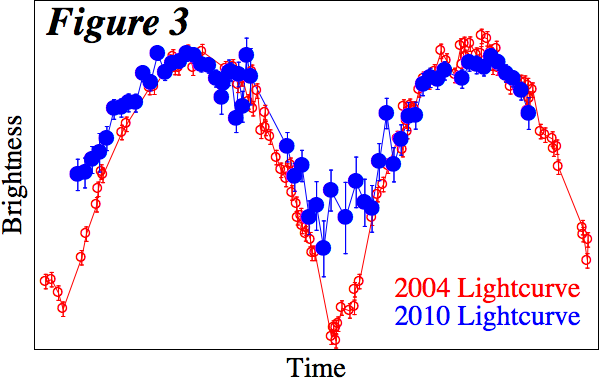
All this week is the 2011 meeting of the European Planetary Society Congress, and earlier today, October 3rd, Pedro Lacerda released the above light curve of the distant Kuiper Belt Object, 2001QG298. (All subsequent images and videos credit to P. Lacerda.)
What shape would it take to cause such a bizarre light-curve? According to Lacerda:
Imagine that you glue two eggs together tip to tip - that's approximately the shape of 2001QG298. It looks a bit like an hourglass.
The object is so distant that we cannot resolve its shape. But this brightness oscillation, called a lightcurve, reveals the strange shape of 2001QG298 as it spins round. The object appears faint at times because one lobe is hidden behind the other, so less area is reflecting sunlight. As the hidden component rotates back into view, we can see the full hour-glass shape. The reflecting area increases and the whole thing looks brighter.
In other words, it's a contact binary whose halves are spinning in-and-out of our line-of-sight!
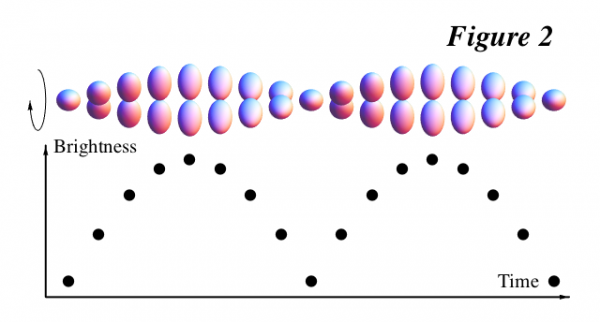
But, of course, you also noticed that the 2004 light curve is substantially different from the more recent one! What could be causing this?
Well remember, like all objects in our Solar System, KBO 2001QG298 is orbiting the Sun! As it does so, we get to see different sides of this object, which means differing amounts of overall light!
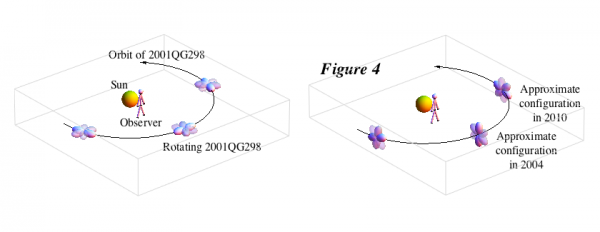
And because we know of so few Kuiper Belt Objects, percentage-wise, this configuration could be common among them. From the press release:
The most important consequence of this finding is that it suggests that this type of double KBO could be very common. When in 2004 Sheppard and Jewitt found 2001QG298 in a sample of 34 KBOs they realised that they were fortunate to spot its binary nature - if it had not happened to be edge-on at the time of their observations, they would not have seen the extreme lightcurve variation. They estimated that approximately 10% of all KBOs are contact binaries, assuming that their tilts are random.
However, Lacerda believes that the tilts of contact binaries may not actually be random and that objects similar to 2001QG298 could be even more common.
"It was a surprise to find that 2001QG298 is inclined by 90 degrees, but that's not the first time we've seen this in a contact binary," he speculates. "There is another famous doublet object, a large Trojan asteroid called 624 Hektor. That object is also tilted almost 90 degrees."
If contact binaries tend to be highly tilted then the chance of spotting their characteristic variable lightcurve is even smaller - only about twice per orbit. The identification of one in a small sample implies that contact binaries may be even more abundant than Sheppard and Jewitt first thought. Lacerda estimates that as many as 25% of KBOs are contact binaries.
From these two sets of observations, Lacerda has been able to reconstruct just what this contact KBO looks like from our point of view, and has put together a video of it, as it spins about its center and travels around the Sun!
- Log in to post comments

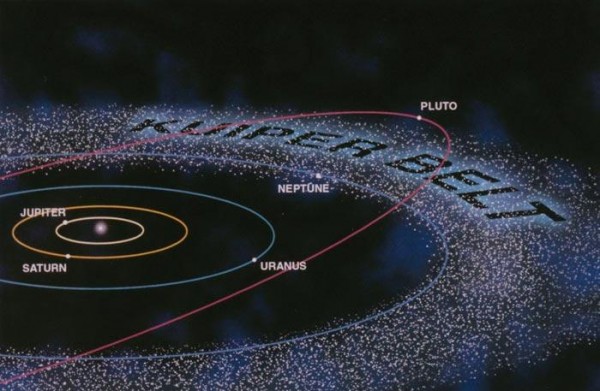

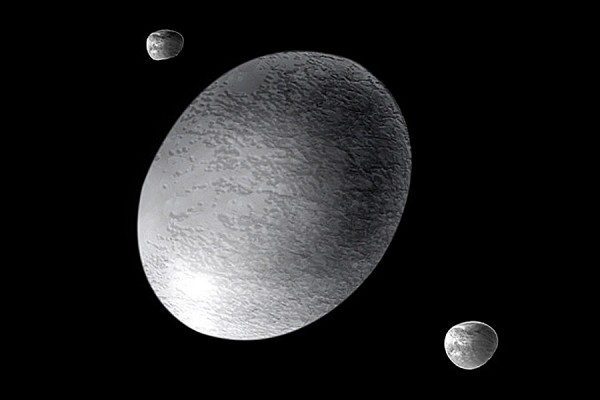
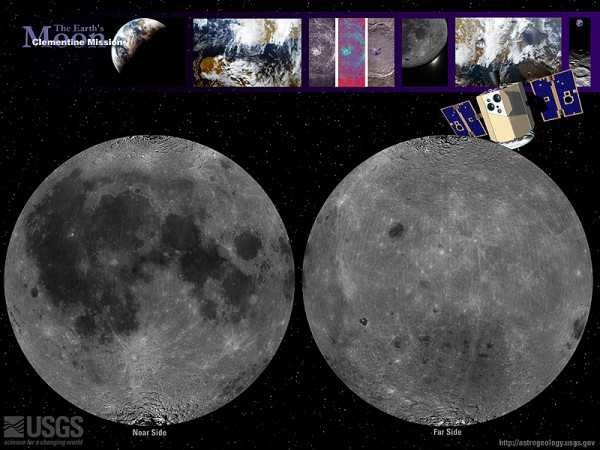
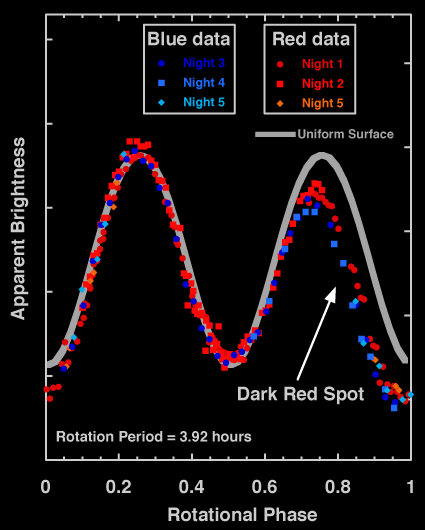
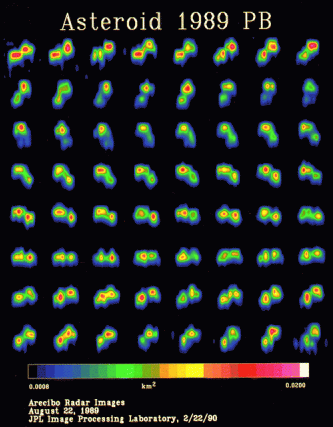

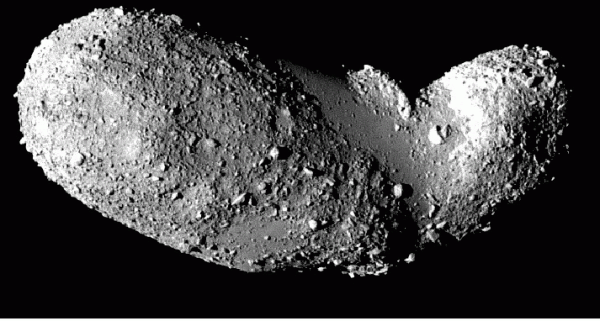
Are there any threesomes or foursomes out there?
@scott
I think they call them rubble piles.
Oh, no. Are we going to have another Big-Endian vs. Little-Endian holy war?
I guess that more that 2 objects would be very difficult to form as they are rotating together, so a contact from a third body would likely get bashed/ground around quite a bit, distributing the remains as rubble on the binary.
Oh man, this was a fun read
Considering that the Pluto-Charon separation is a few Pluto radii, it could be "an almost contact binary".
Btw, I recently read that it is likeliest a product of a (low velocity) impact, making it the closest analogue to the Earth-Moon system and a dismay for the Rare Earthers!
@ Randy Owens:
But you can't make a planet system without breaking some worlds.
All very interesting, but I'm not sure why contact planetoidal binaries are so mind-blowing. It seems we'd expect some bodies to gently come together, or in a random distribution of relative velocities was that thought unlikely?
The assemblies as shown look rather unstable.
Why don't the two bodies roll around until their respective centers of gravity come (approximately) as close to each other as possible?
"To me it made no sense to pull one of even a few objects out of the swarm and call them something other than part of the swarm." -Mike Brown
Brown is incorrect here because he is only telling part of the story. The dwarf planets are not just a few objects randomly "pulled out of the swarm." They are objects much larger than the majority of Kuiper Belt Objects, large enough to be pulled into a round shape by their own gravity. Because of this, compositionally, they have far more in common with the planets than with the vast majority of tiny, shapeless KBOs. These objects have geology and weather; some are known to be geologically differentiated into core, mantle, and crust, just like the Earth is. Pluto is the only other planet besides Earth in this solar system to have nitrogen in its atmosphere. It may even have a subsurface ocean that could harbor microbial life. Brown blurs the distinction between these small but complex worlds and tiny, simple KBOs by defining objects only by where they are and ignoring what they are. As an astronomer, I hold to an alternative, equally legitimate view, the geophysical planet definition. According to this definition, a planet is any non-self-luminous spheroidal body in orbit around a star. Our solar system has three, not two classes of planets--terrestrials, jovians, and dwarf planets. The dwarf planets just happen to be the most numerous, in the same way that dwarf stars are the most numerous type of stars, and dwarf galaxies are the most numerous type of galaxies.
@Pierce R. Butler: FWIW, my educated guess is that it might involve tidal forces. Those would tend to attract them with the long axes towards each other. I probably wouldn't have thought they would overwhelm the straightforward gravity, but tides are inverse cube, versus gravity's inverse square, so perhaps it could predominate at such distances.
Scott, you're on the wrong site for that sort of question ;o)
Nice article Ethan!
Randy, the precise square-cube law breaks down when the size of the objects interacting and the deviations from perfectly spherical become comparable.
You can measure the mass of a mountain with a good plumb line, an accelerometer and a lot of walking.
Outer space has always interested me because I canât totally comprehend the concept of something so vast it goes on forever. Reading this it only made me wonder more about what new planets or galaxies might be discovered later on maybe 100 years from now. New discoveries are always being made and it is just so fascinating to read about. This blog entry left me with more questions than answers which Iâm pretty sure isnât a bad thing, its made me think about the endless possibilities of space.
I now live at the edge of the milky way
Why would any of this seem strange? Are we not taught that planets are formed from other "stuff" that coalesces. Could not a contact binary, or any other large body, form a coalescence point that will slowly draw other bodies to it?